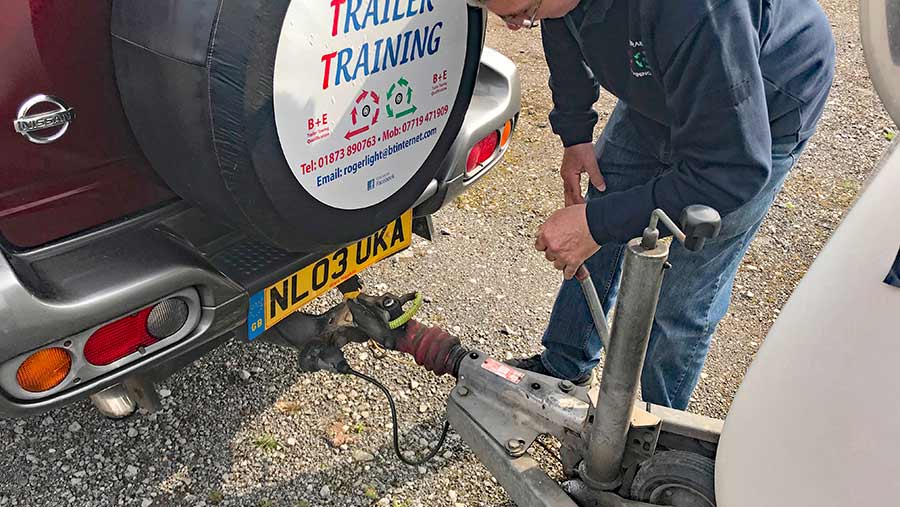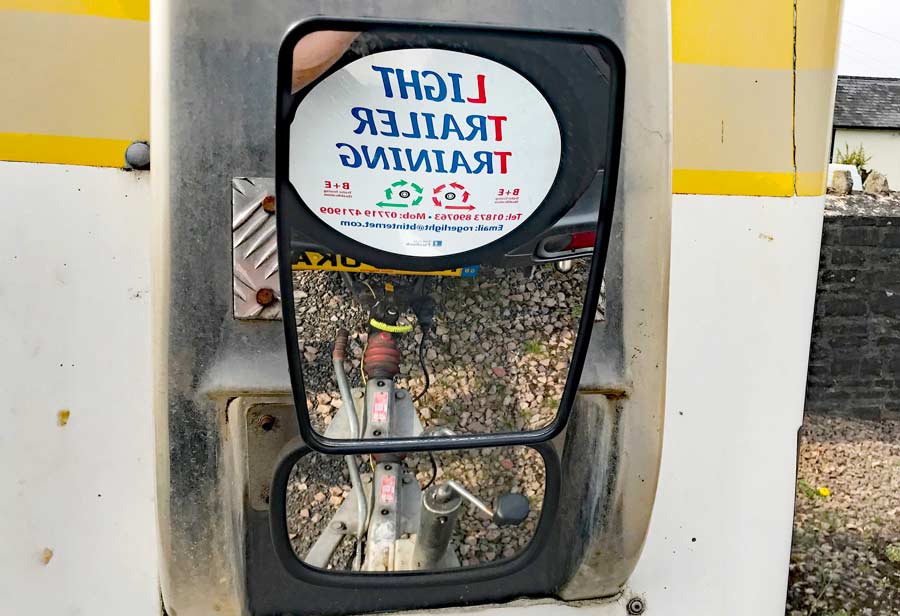Video: All you need to know about passing your B+E trailer test
So you’ve been driving since you could reach the pedals, passed your tractor test at 16, car test at 17 and can reverse 40ft trailers around the yard for fun.
Yet if you want to take the stock box to market behind the Land Rover there’s another pesky hurdle standing in your way.
Yes, it’s the B+E trailer test, and for those passing their driving test after 1997 it is illegal to tow heavy trailers without it.
For those in this situation, the only option is to bite the bullet and sign up for another grilling.
Sadly this doesn’t fall into the category of more practical farm-based tests (such as the rough-terrain forklift) so it means dealing with the DVSA.
The upshot of this is that the candidate is basically taking a driving test all over again.
Thankfully there’s no computer-based theory element, but the practical part is judged in a similar way, albeit with a more complicated set of manoeuvres to master.
In fact, it’s a bit like a watered-down version of the HGV test.
On the Farmers Weekly machinery desk we’ve all taken and thankfully passed the B+E, but like a lot of people, some of us put it off longer than we should.
Below we offer some advice based both on our own experiences and that of the instructors who helped us.
See also: Top tips for passing your telehandler test
Watch the video and read the full report below.
Who needs to take the test?
Everyone who passed their car (category B) test on or after 1 January 1997 has to take the B+E to tow a vehicle and trailer combination weighing more than 3.5t.
The rules are all based on weight, so it is possible to tow a trailer behind a car on a standard driving licence, providing the whole outfit weighs no more than 3.5t (See Towing limits explained, below).
People who passed their driving test before 1 January 1997 are generally allowed to tow trailer and vehicle combinations up to 8.25t.
Towing limits explained
Category B – test passed before 1 January 1997
People who passed their category B car test during this time are generally allowed to drive a vehicle and trailer combination up to 8,250kg maximum authorised mass (MAM)*.
They are also allowed to drive a minibus with a trailer over 750kg MAM.
Category B – test passed on or after 1 January 1997
Drivers passing their test on or after this date are limited to driving vehicles with up to eight passenger seats and a MAM of 3.5t, plus a trailer up to 750kg.
However, it is possible to tow heavier trailers than this if the total MAM of the vehicle and trailer is no more than 3.5t.
For example, a fairly standard Isuzu D-Max weighs just over 1.9t and a 12ft Ifor Williams stock trailer is about 1.3t. Together they come just under the 3.5t limit, but when people and cargo are added it soon becomes illegal.
Category BE
Passing the B+E test entitles the driver to tow trailers with a MAM of up to 3.5t, providing the gross train weight (vehicle plus trailer plus load) is no more than 7t.
If the towing vehicle weighs more than 3.5t, C1 and C1+E licences will be required.
Those that passed the B+E before 19 January 2013 technically have no limit on the size of trailer they can tow. However, it is important to note that drivers should not exceed the towing capacity of their vehicle and trailer.
*Maximum authorised mass (MAM) means the weight of a vehicle or trailer including the maximum load that can be carried safely when it’s being used on the road. This is also known as gross vehicle weight (GVW) or permissible maximum weight.
At what age can I take the test?
The age limit for taking the B+E test is 17, but applicants need to have passed their driving test before they can apply.
For those planning to take an HGV test, the B+E can be avoided. However, it’s important to note that this has to be a C+E licence as the C only applies to rigid trucks with trailers up to 750kg.
The age restriction for this is 18, having been reduced from 21 in 2009.
Another option is to take the C1 test (trucks up to 7.5t) followed by the C1+E test.
What’s involved?
The B+E test is comprised of two distinct sections. The first takes place in the test centre where the driver will need to unhitch and hitch the trailer, carry out a visual check, answer some theory questions and perform a set piece reversing manoeuvre (see Reversing manoeuvre).
Once this is completed, the road-based element of the test will begin. This usually takes about an hour and features several tasks.
These typically include a section of free driving following road signs, a series of pull-ins and pull-outs on flat, uphill and downhill slopes, plus negotiating some tricky road features.
Expect lines of parked cars, bus lanes with defined operating hours and tight corners with curbs that are all too easy to hit.
When should I take the test?
Launching straight into the trailer test after passing the driving test has some benefits, as the driver hasn’t had chance to develop bad habits and knows the routine.
However, it’s arguably more important to build up a little confidence of driving on the road. Having added experience means drivers are generally able to read the road and anticipate hazards more effectively.
For those who plan to take the test with less than 12 months of driving experience, it’s worth spending a bit of extra time with an instructor.
Do I need to get training?
Even trailer-reversing ninjas are pretty much guaranteed to fail the test if they go in cold.
This is because surprisingly little of the examination is actually focused on reversing, making it more of an advanced driving test.
For those who do their homework religiously and prepare their vehicle properly it is possible, but we’d advise seeking the help of an instructor.
As well as running through all the elements of the test, they’ll point out the tricky road features that examiners will throw in to test the driver’s ability.
These can include things like a bizarre speed limit change that few people spot, a tricky turn out of a one-way street, or a complicated traffic calming system.
Can I use my own vehicle and trailer?
It is possible for someone to use their own vehicle and trailer, but they need to make sure it meets the stringent test requirements.
This means jumping through a number of hoops, including fitting mirror extensions for the examiner, L-plates and a properly secured ballast that brings the total trailer weight to at least 800kg. Many examiners use an IBC tank filled with water for this purpose.
Fitting a reversing mirror or camera to help inch up to the trailer accurately is another sensible move.
It’s also important to note that the vehicle must be in perfect road-going condition with no warning lights on the dash. There must be a matching number plate on the trailer, too.
Most instructors will help those wanting to use their own vehicle and provide some of the equipment needed to set it up properly. However, to take the vehicle out of the test equation, all of us at Farmers Weekly opted to pay a little extra to use instructors’ equipment.
It’s also worth noting that if the test is taken in an automatic car, drivers will only be permitted to tow with automatic vehicles after passing the test.
Full requirements for the vehicle and trailer can be found on the government’s website
Where can I find an instructor?
There are scores of instructors across the country that specialise in getting drivers through the B+E test – a quick web search should bring up a few in your area.
Some will be larger corporate firms with teams of instructors, while others are one-man-band operators that offer a more personal approach.
How much training will I need?
For those with plenty of driving and trailer-towing experience it is possible to do a few hours of training and take the test the following day.
However, it is more common for people to take a day-and-a-half or two days of training before being thrown in at the deep end.
For those with little reversing experience it’s a good idea to have an initial session with an instructor to get the basics. It’s then sensible to master reversing at home before coming back to learn how to pass the test.
How much will it cost?
People that fancy going it alone will only have to fork out for the DVSA test fee, which costs £115.
Popular all-inclusive day-and-a-half courses with the test taking part in the afternoon of the second day start at about £500.
Obviously shorter courses for the very experienced will be a little less and those requiring extra tuition will need to pay a bit more.
It’s worth noting that prices fluctuate depending on the area.
How easy is it to pass?
The current pass rate is 70%, which has crept up from 64.5% in 2010. According to the DVSA this is most likely due to candidates being better prepared and knowledgeable. Most instructors will quote higher pass rates among their trainees, often more than 80%.
During the test itself, examiners are looking out for three types of fault – general driving faults, serious faults and dangerous faults.
Drivers can make up to 15 driving faults and still pass, but just one serious fault or dangerous fault constitutes a fail. Repeatedly making the same driving fault can result in the examiner issuing a serious fault.
Interestingly, it’s a lot more common for people to fail on the road element of the test than the reversing manoeuvre and hitching exercise.
What happens if I fail?
It’s a tricky test so there’s no shame in failing it. At the end, the examiner will point out where the candidate has gone wrong so that they can work on these areas for next time.
There’s just a three-day break before a retest can be taken, and most instructors will offer quick refresher courses to help prepare for it.
What can I tow after the test?
Passing the test entitles the driver to tow a trailer behind a car or 4×4 up to a maximum of 3.5t, providing the whole outfit plus load doesn’t exceed 7t.
However, the driver is still governed by the plated towing capacity of the vehicle, which in many cases will be less than 3.5t. Even some of the most recent pickups from big-name brands have lower ratings than this. There will be a plate on the vehicle or a note in the handbook confirming its capacity.
Those planning to tow for business use that isn’t classed as agricultural could also be required to fit the towing vehicle with a tachograph.
What happens if I tow illegally?
Those caught towing illegally can face a weighty fine plus points on their licence. It’s also likely that a driver’s insurance will be invalid, which can have more severe consequences.
The reversing manoeuvre

To anyone well versed in reversing trailers, the DVSA’s set piece manoeuvre will at first seem a doddle.
All drivers have to do is perform a slight left turn, before straightening up and parking in a bay made of cones.
But there is a little more to it. Firstly, the area is quite tight, meaning positioning needs to be bang on to complete it cleanly.
There’s also no swinging around to slew the trailer vaguely in the right direction before starting.
Examiners will be checking for the proper use of mirrors, too, so hanging your head out of the window won’t go down well.
At the end of the exercise, the extreme rear of the trailer has to be within a 1m stopping area and there is only one opportunity to get out and check this is correct.
For those wanting to take the test on their own it’s a good idea to set up one of these bays and practice until they nail it every time.
Instructors will have a foolproof routine for trainees to follow.
During the test, drivers will have two opportunities to correct the manoeuvre and one chance to get out and check that the rear of the trailer is within the 1m stopping area.
The reversing task will also be teamed with an unhitching and hitching exercise, which has a set procedure to make sure it is completed safely.
Here examiners are looking for correct use of the handbrake, breakaway cable and jockey wheel as well as the driver’s ability to check the trailer is properly attached and in roadworthy condition.
Instructor’s tips

Roger Light, Light Trailer Training, Abergavenny, Monmouthshire
Test centre: Newport
Tips for success
- Examiners are not looking to fail you and they will generally giveyou time to remember tasks you’ve forgotten to do. If there’s a pause before they give you the next task, double check you’ve remembered everything.
- Stay alert and pay close attention to road signs and any hazards you spot. I say to my pupils that you should “drive what you see” and if you do this effectively you’ve got a good chance of success.
- Tell the examiner what you’re doing. If they ask you to perform a manoeuvre and you see a hazard or feel you’ll cause other road users to have to stop or slow down, point this out and tell them what you’re planning to do about it.
- Some people struggle with nerves, but it really pays to keep then under control. A level head will help you anticipate the road and make better decisions.
Common mistakes made by students
- Poor judgement when overtaking cyclists
- Failing to check mirrors and blind spots
- Causing other road users to stop or slow down
- Improper use of the breakaway cable and handbrake
- Forgetting to check the trailer is in roadworthy condition
You can find more details on the B+E test on the government website



